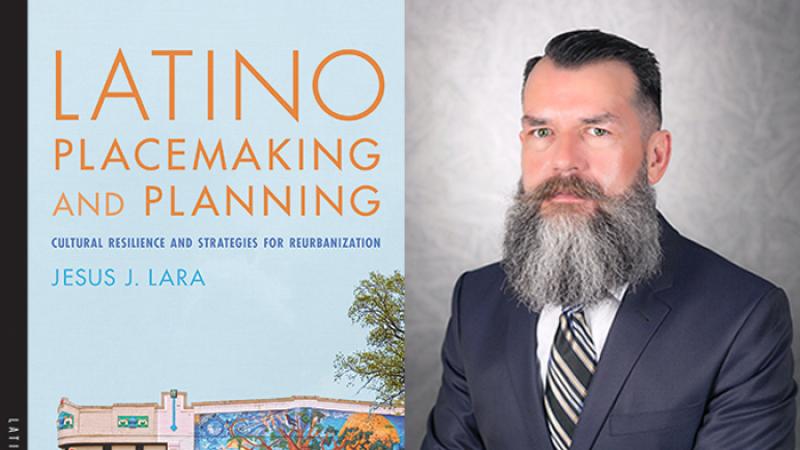Jesus J. Lara Publishes Latino Placemaking and Planning: Cultural Resilience and Strategies for Reurbanization: An Interview
“Lara’s work on Latino urbanism both contributes to the rapid evolution of the field and strengthens an epistemic community around it. With this book, Lara both meta-analyzes the field and propels it forward.”—Clara Irazábal-Zurita, Director of Latinx and Latin American Studies, University of Missouri–Kansas City
Associate Professor of City and Regional Planning Jesus J. Lara addresses issues of Latino urbanism in his new book, Latino Placemaking and Planning: Cultural Resilience and Strategies for Reurbanization. The book offers a pathway to define, analyze, and evaluate the role that placemaking can have with respect to Latino communities in the context of contemporary urban planning, policy, and design practices.
The Knowlton School interviewed Professor Lara to discuss his research and proposals on the release of his new book.
Can you briefly describe characteristics of Latino urbanism?
Latino urbanism is an emerging approach to planning, design, and development that responds to Latino lifestyles, cultural preferences, and economic needs that are reflected in the built environment. Latino urbanism is reflected in the way Latinos bring key qualities that are essential to the revitalization process of our cities, including socialization, leisure activities, and commerce. It is a design and planning concept based on how Latinos organize and use space. Proponents of this movement argue that Latino urban living in modern American towns and cities can incorporate many of the principal tenets of new urbanism and sustainable urbanism: compact urban form, pedestrian activity, public transportation, sustainability, recycling, and active use of public and private spaces.
Can you provide a brief list of several of the specific case studies examined in the book?
This book examines the development of ethnic entrepreneurship, identifying the signs of socioeconomic revitalization which can appear in the urban landscape of new Latino immigrant communities. A number of case studies of commercial corridors revitalized by Latinos from selected cities across the country are analyzed, including Phoenix, Arizona; Detroit, Michigan; Columbus, Ohio; and Indianapolis, Indiana. The types of projects examined are intentionally diverse and encompassing a wide range of activities of varying scales across the country.
The Latino presence is becoming visible in two distinct areas of Columbus. The west side has been a magnet for largely Mexican immigrants principally along the Sullivant Avenue Corridor, slowly spreading from there. The other area that is becoming a favored destination of immigrants is the northeast part of Columbus along the Morse Road Corridor. This area is heavily populated by not only Latinos but by immigrants from Africa and Southeast Asia. Here, too, the principal Latino group is Mexicans.
What are the signs that show how the Latino population produced an “urban revitalization through the (re)appropriation of the physical space for their own use”?
When immigrants come to the United States, they bring cultural traits that influence how they use public spaces and carry out social life. For instance, in ethnic commercial corridors, businesses use graffiti, flags, and murals of pastoral scenes from Latin American countries to inexpensively assert their identities and claim ownership of the area. Also, the use of colors and graphics in advertisements for products and services provides strong visual statements that signal the presence of specific ethnic groups. Food is an intrinsic part of Latin American culture and it is available everywhere in ethnic corridors, whether from street vendors or mobile “taquerias” to the most exclusive and expensive of restaurants. Food, like the colors and icons, is a visual cue used by entrepreneurs to engage regular customers and to entice new ones.
From the perspective of Placemaking and Planning, can you provide some of recommendations for “reurbanizing” the city?
The principal issues to be addressed here include appropriate responses to an urban population’s increasing levels of diversity and consequently changing demands on infrastructure. This book provides a series of guidelines and recommendations for establishing enabling systems in planning and design policy which reflect the linkages between immigration and the physical environment in terms of three factors: population growth, neighborhood revitalization, and economic development. Some of the recommendations include:
a. Capitalize on destinations and attractions that celebrate local ethnic entrepreneurial spirit.
b. Capacity building and understanding the interrelations that are needed to make planning happen.
c. The physical environment needs to be addressed in urban design in any inclusive and responsive form of planning.
Latino Placemaking and Planning: Cultural Resilience and Strategies for Reurbanization is available at Amazon and The University of Arizona Press.


